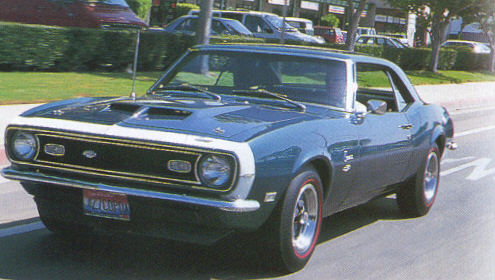
Extract from Australian magazine "Performance Street Car"

THE GENERAL MOTORS'response to the 1964-112 Ford Mustang'Pony Car'was the release of the'F-Body'car called the Camaro, and for the past 30 years these machines have been loved worldwide. The 1967 Camaro was developed on the Chevrolet'Chevy li'piatform to keep the budget down, and by the time the GM Design Staff was finished with it, the Camaro had a look all its own and looked nothing like the much more pedestrian Chevy 11 compact that it was based on. F-Body cars (released in late 1966) featured a new'unit construction'chassis design, which had front and rear sub frames rather than a conventional frame. The front suspension featured coil springs with unequal length A-arms, and on the rear, mono-leaf springs were used. To isolate the body from noise and vibration, rubber biscuits were used and the wheelbase stood at 108.1 -inches.
The Camaro's body was very sleek and it was one of the
first General Motors products to extensively tested in the wind tunnel.
For performance buyers a popular option was the'Super Sport 350'package
(all 55 Camaros had a front 'bumble bee nose stripe) and it featured
a new 350-cube small block mill that developed 295 horsepower. A
327-cube engine (275 hp) was the standard VS and the top-of-the-line
power plant was the'178' 396 big block, rated at 275 horsepower.
Three and four speed manual transmissions were available, and
both a two-speed Powerglide and three-speed Turbo Hydra Matic
automatic transmission were offered. One
optional Camaro was the'Z/28' model, and it was unique because of
its engine. Between the front frame rails sat a 302-cube V8
that was a crossbreed of a 350 engine fitted with a 283 crankshaft
giving it a 4-inch by 3-inch bore and stroke layout. This combination
of parts gave high revs and lots of power from a small package!
A 346-degree camshaft, big Holley
four barrel carb and hi-flow cast iron headers were part of
the Z/28 engine package, and the 302 was given a power rating of
290 hp, while all the magazine writers of the day said it had
to deliver much more!. Part of the reason Chevy down played the power
of this limited edition model was to help get it legalised for the
popular SCCA (Sports Car Club of America) Trans-Am racing series.
F-41 heavy duty suspension pieces, front disc brakes, metallic shoed
rear brakes, quick ratio steering (24:1) and 1 5 x 6 Rally
wheels (borrowed from the Corvette) were factory add ons for the'Z,as
was a cowl induction hood. Only 602 Z/28 optioned Car-naros
were built in 1967, making them among the most rare F-Body cars of
all time!
For 1968 the Camaro line was kept nearly identical as the '67s, save for the new required side marker lights and the updated "Astro Ventilation'system that eliminated the side vent windows. Four-wheel discs could now be ordered on Z/28s and all Camaros now had staggered rear shocks. The 1969 Carnaro saw some body changes (new fenders, doors, quarters) and a new grille. Wheel openings were now more squared off and the cat was slightly longer and wider, and appeared to sit lower with a strikingly different profile. The restyled 1969 cars were sold for an extended five months because of a delay in introducing the all new 1970 models which have now become known around the world as "1970-112'Camaros, which debuted in late February, 1970.
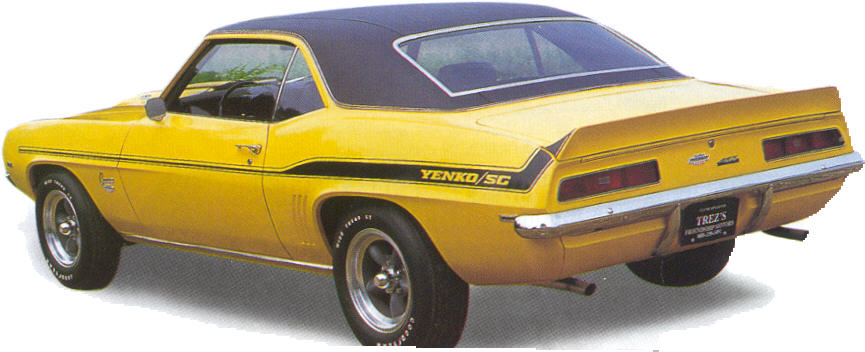
BUILT ON A completely new platform (but still
with a 1 08-inch wheelbase) the second generation F-Body
was two inches longer, an inch lower and slightly wider. The semi-fastback
body had much longer doors and the rear quarter windows were eliminated.
Standard Camaros had a full width front bumper while
optional Rally Sport models featured a pair of'rnini bumpers'and a more
pronounced grille, complete with a urethane tipped frame.
The 1970-112 Z/28 now came with a larger 350- cube engine (known as the LT-1) and this hot new mill featured large port cylinder heads, 2.02'intake and 1.60'exhaust valves, a forged steel crank, forged 1 1:1 pistons, high lift mechanical camshaft, big Holley four-barrel and aluminium intake. power was rated at 360 hp, and interestingly enough, the very same power plant fitted into a 1970 Corvette had a 370 hp listing.
The camaro styling was changed very little
for 1971-72 but the engines got less compression and more smog equipment,
thanks to the US government clarnping down
on emissions. For 1973, the Type LT, (luxury Touring)
model was introduced and this optional package was a replacernent for the
"SS' version, and had features like ,wood grained
dashes, body colour sport mirrors and Rally Wheels. Big block power was
gone in'73 and the Z/28 engine was now fitted with hydraulic lifters.
1974 saw the installation of huge "bumper car front and
rear bumpers (to meet new government standards) and the Chevy stylists
added a new sloped grille to facilitate the aluminium faced bumper and
the rear tail lights were revised as well. For the '75 Camaro, the Z/28
option was eliminated and the rear window was changed to a wrap-around
design. Other new items for the 1975 Carnaro was HEI (High-EnergY ignition),
and the use of catalytic converters. No big changes came for Camaro buyers
for 1976 but by mid-1 977, the decision was made to bring back the Z/28
and this time the option dealt
with increasing handling rather than brute power. The'78 Carnaro had new.moulded
in'front and rear treatments and in 1979 the Berlinetta name was given
to the old 'Type LT" model. By 1981 the second-generation body was
getting very dated and the automotive world was very glad to hear that
GM was launching a brand new third- generation F-Body for the 1982
model run.
THE REDESIGNED'82 CAMARO had a shortened wheelbase
(down from 108 inches to 1 01 inches) and an 1 8-inch shorter body.
MacPherson strut front suspension was fitted and coil springs replaced
the rear leafs. The new body was very sleek and featured a glass
rear hatchback design, along with standard fold- down rear seats
for added cargo room.
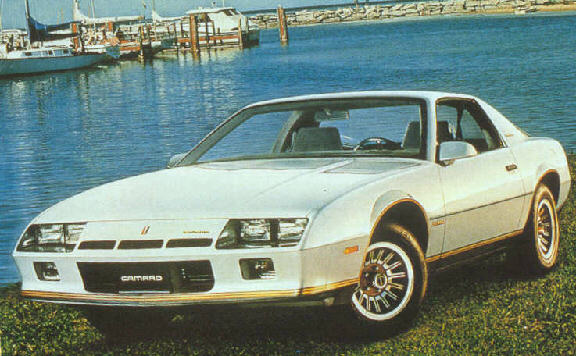
A'Cross-Fire'fuel injected S.OL small block was optional on the Z28, but unfortunately, it only mustered some 165 horsepower and could only be fitted with an automatic transmission. The car looked great, cornered superb and stopped well but had little grunt when the accelerator was floored! 1983 saw the production of a slightly more powerfui'High Output' L69 (190 hp) Z28 that had a hotter camshaft, less restrictive exhaust and more ignition tirning. The Cross-Fire was neat looking but the Chev engineers discarded it in favour of a large four-barrel carb. A new TS Borg-Warner five-speed manual transmission was now available, giving much improved performance as compared to the'82 automatic equipped version. 1984 Camaras were virtual carry-overs from the'83 models.
The International Race of Champions Series used Camaro bodies starting in 1 985 and to help promote the production cars, Chevrolet released a "IROC-Z' Camaro that was now the flagship of the line. IROC-Zs came fully equipped with four- wheel disc brakes, 16 x 8-inch alloy wheels, Goodyear "Gatorback'sticky rubber and special suspension.
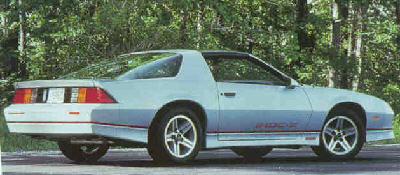
Power was provided by either the L69 305-cid mil or a new'Tuned Port lnjection'LB9 V8,that delivered 21 5 ponies from its 5.0 litres. On the skidpan, the IROC- Z was awesome and this new TPI engine helped quarter mile performance. The 1986 models changed little and the big news for performance lovers in'87 was the larger 5.7-litre Corvette derived Tuned Port engine, but unfortunately it was not available with a manual transmission. Also, 1987 saw the return of the convertible Carnaro, the first "drop-top'F-body since 1969! In 1989, the'] LE'option package was introduced, and it was a favourite with road racer types. Fitted with trick components like Corvette front disc brakes, an aluminium drive shaft and ultra stiff suspension, these special cars were only available without air conditioning and were very good handling machines. While everyone thought the factory would make a special edition'25th Anniversary'edition of the Chevrolet pony car, no such machine was built. It wasn't until the release of the fourth-generation F-Body, the brand new 1993 Camaro, that things got exciting again for Camaro enthusiasts.

COMPLETELY REDESIGNED from nose to tail, the all new'93 Camaro had a fresh, contemporary look to it and was longer, wider, and taller than its predecessor. But all the classic Camaro design ingredients were evident; the smooth upper body, tenacious stance, aggressive front end treatment and brawny wheels and tyres. The 1997 Camaro'SS'LT4 features the 330-hp Corvette engine (with ram air) and performance is even more impressive than standard Z28 models. SLP Engineering is responsible for the creation of this ultra hot F-Body, and they are certain to become instant collector cars ... 0-60 mph can be reached in just five seconds flat and the quarter mile can be had in 13.6 seconds @ 106 mph. With a top speed of 161 mph, this special 30th Anniversary model (of which only 1 00 were built) is a true modern day muscle machine that surely the original Camaro designers would be proud of.
THE NEW 1998 CHEVY'PONY CAR' will get a definite double
take from Camaro enthusiasts worldwide when it is released later this year.
Most noticeable from the outside is a new front end that features new fenders,
hood, front fascia and new composite headlamps.
Perhaps what the performance buffs will most appreciate about the'31 st'
Camaro is what's under the hood of the Z28 models... a 305 HP version of
the LSI V8 from the Corvette!
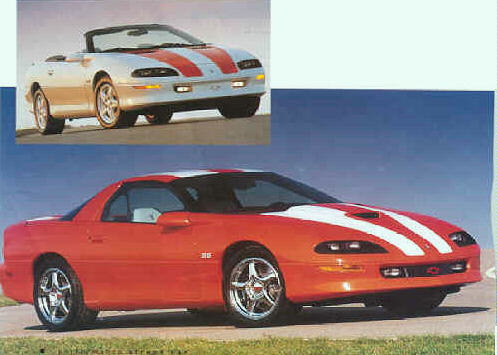
'The LSI engine in the 1998 Camaro weighs about 1 0-percent less, fully dressed, than the LTI engine it replaces. The result is an engine that's lighter, more powerful and quieter,'said GM Power train's John Juriga. Suspension upgrades include new spring rates and retuned shocks front and rear, and an all new standard equipment Bosch ABS system was developed. A new traction control system is available optionally for Z28 and 55 buyers, and a'more pleasing'exhaust tone was added, thanks to larger mufflers. 55 Camaros also have new power steering coolers, a rear spoiler and forced-air induction hood. Power increases for the SS version is to be announced at a later date.
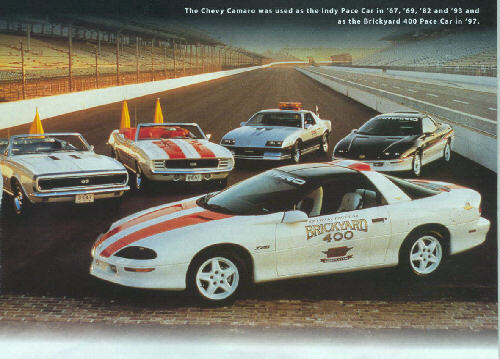
Extract from Australian magazine "Performance
Street Car"